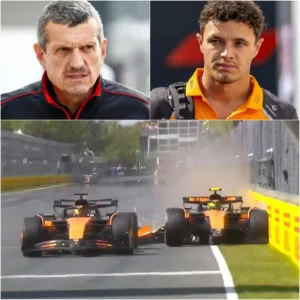In a stunning turn of events at the 2025 Formula 1 Canadian Grand Prix, Red Bull Racing has launched a protest against George Russell’s victory, accusing the Mercedes driver of engaging in “illegal” behavior during the race. The dramatic protest, which unfolded following the conclusion of the race, has sent shockwaves through the motorsport world, sparking heated debates among fans, pundits, and drivers alike. Red Bull’s protest claims that Russell’s actions behind the safety car were in violation of Formula 1’s sporting regulations, a move that could have serious implications for both Russell and his team.
The controversy began in the final stages of the race when a safety car was deployed following a collision between McLaren drivers Lando Norris and Oscar Piastri. The field bunched up behind the safety car, and George Russell, who was leading the race at the time, found himself in a tense battle with Max Verstappen, who was in second place. According to Red Bull’s protest, Russell’s behavior during the safety car period was questionable, alleging that he intentionally slowed down and caused Verstappen to overtook him. This maneuver, Red Bull claims, was a deliberate attempt to disrupt the flow of the race and gain an unfair advantage, thereby breaching the rules of fair competition.
Red Bull’s protest focuses on the idea that Russell’s actions were inconsistent with the regulations surrounding behavior behind the safety car. The team argues that drivers are required to maintain a certain speed to prevent any undue advantage or disruption to the race. By allegedly slowing down at strategic points, Russell is said to have violated this principle, allowing Verstappen to gain an advantage and possibly changing the outcome of the race. Red Bull also claims that Russell’s actions displayed unsportsmanlike behavior, arguing that it was a calculated attempt to manipulate the race.
In response to the protest, Mercedes has vehemently defended their driver, George Russell. Mercedes team principal Toto Wolff wasted no time in labeling the protest as baseless, stating that Russell’s actions were completely within the rules. Wolff emphasized that the slow pace behind the safety car was a result of maintaining tire temperatures and braking efficiency, which is a standard practice for all drivers during a safety car period. Mercedes further asserted that Russell was simply following the necessary procedures to ensure his car’s performance remained optimal for the final restart, without any malicious intent or effort to gain an advantage over Verstappen.
Despite the counterarguments from Mercedes, Red Bull’s protest has garnered attention for its potential to shake up the outcome of the race. With Verstappen finishing in second place, a decision to penalize Russell could lead to a reversal of the results, with Verstappen being declared the winner. Such a decision could have significant implications for the championship standings, potentially giving Red Bull a crucial boost in the ongoing title race. The FIA, which is responsible for investigating and resolving protests, has yet to make an official ruling on the matter, but the situation is far from over.
As the protest is reviewed by the FIA, many are questioning the broader implications of this incident for Formula 1. The protest highlights the growing tensions between Red Bull and Mercedes, two of the sport’s most dominant teams. While both teams have been involved in intense battles for supremacy on the track, this protest represents a new level of conflict off the track, with teams now seeking to challenge each other through the protest system. The growing frequency of protests in recent seasons has led to calls for reform in how they are handled, with some suggesting that the process is being used as a tool for strategic advantage rather than genuine disputes.
The FIA now faces a challenging task in resolving the issue. The governing body must determine whether Russell’s actions were indeed in breach of the regulations and, if so, what penalty, if any, is appropriate. Given the high stakes of the situation, any decision made by the FIA is likely to have far-reaching consequences, not just for Russell, but for the entire sport. A ruling in favor of Red Bull could lead to calls for further scrutiny of safety car procedures, while a dismissal of the protest could reignite tensions between the two teams and their respective fanbases.
In the coming days, the Formula 1 community will be eagerly awaiting the FIA’s decision. If the protest is upheld, it could mark the beginning of a new chapter in the intense rivalry between Red Bull and Mercedes. If the protest is dismissed, it will be a powerful statement about the limitations of the protest system and the integrity of the sport. Regardless of the outcome, this incident is sure to add to the already high drama of the 2025 Formula 1 season, further intensifying the battle for the championship.
The Red Bull protest against George Russell’s victory is a reminder of how razor-thin the margins can be in Formula 1. A seemingly minor incident, such as behavior behind the safety car, has the potential to alter the trajectory of a season. As the sport evolves and the stakes continue to rise, protests like this may become more frequent, leaving teams, drivers, and fans on edge until the final whistle blows.






